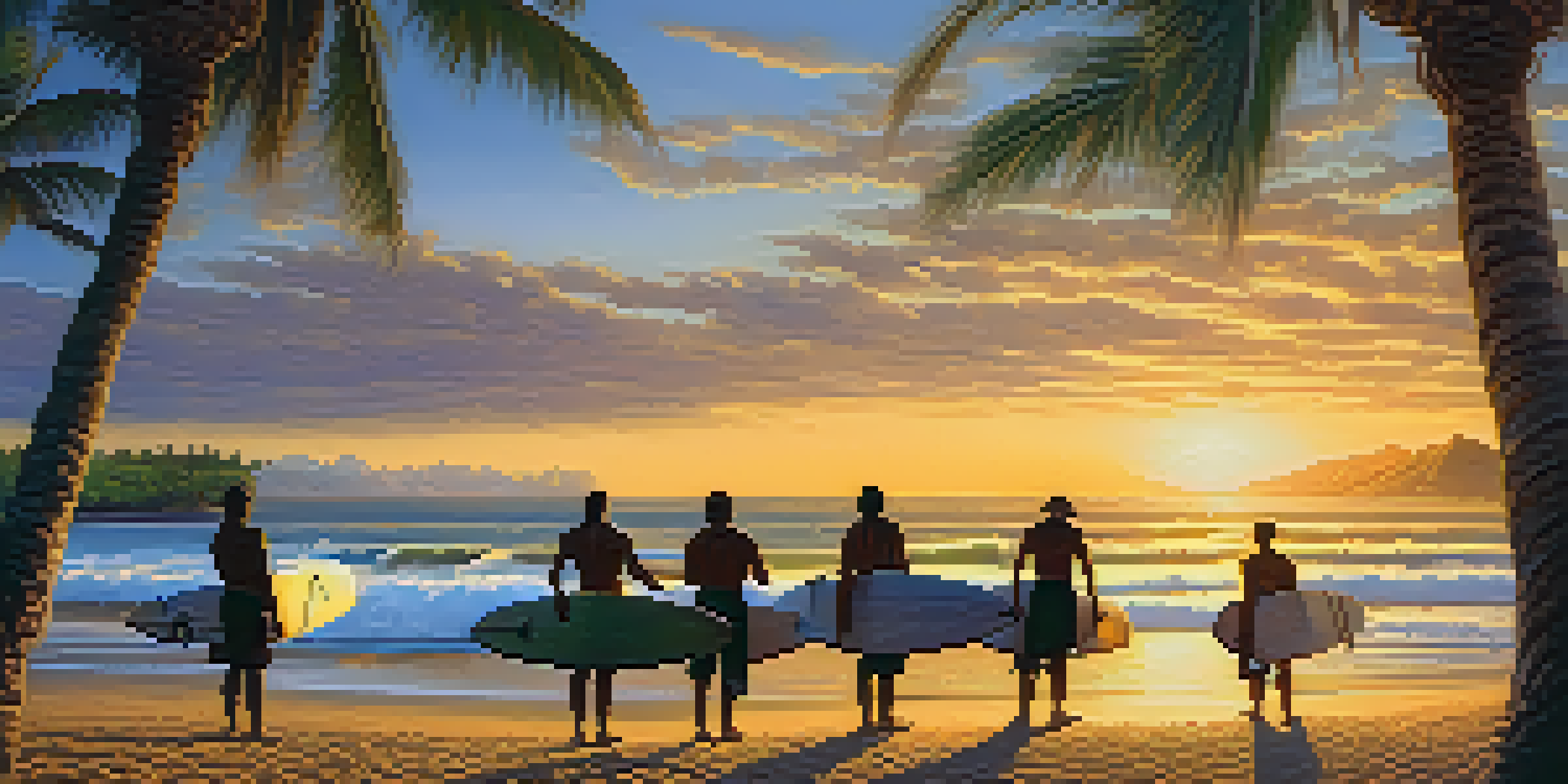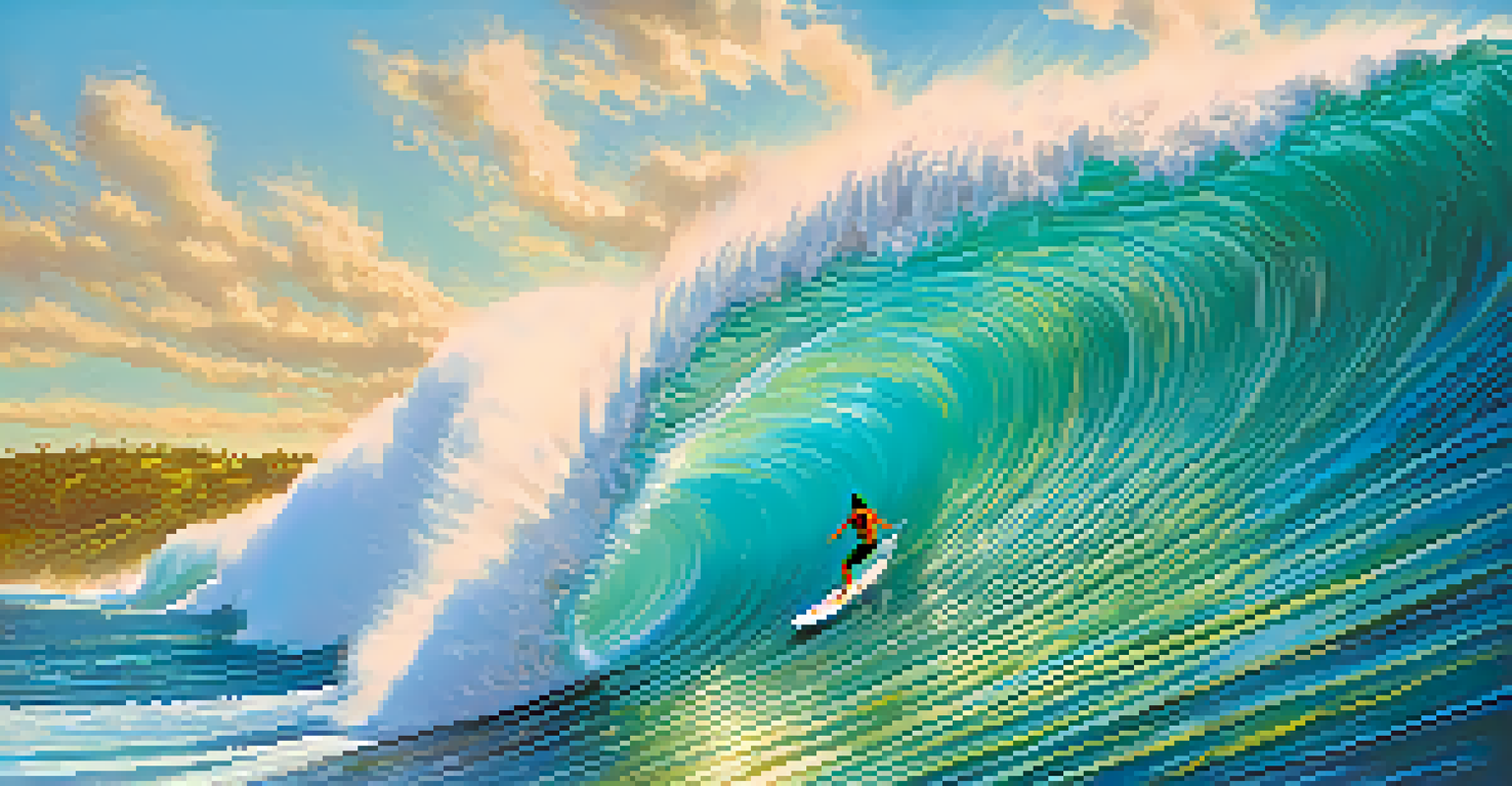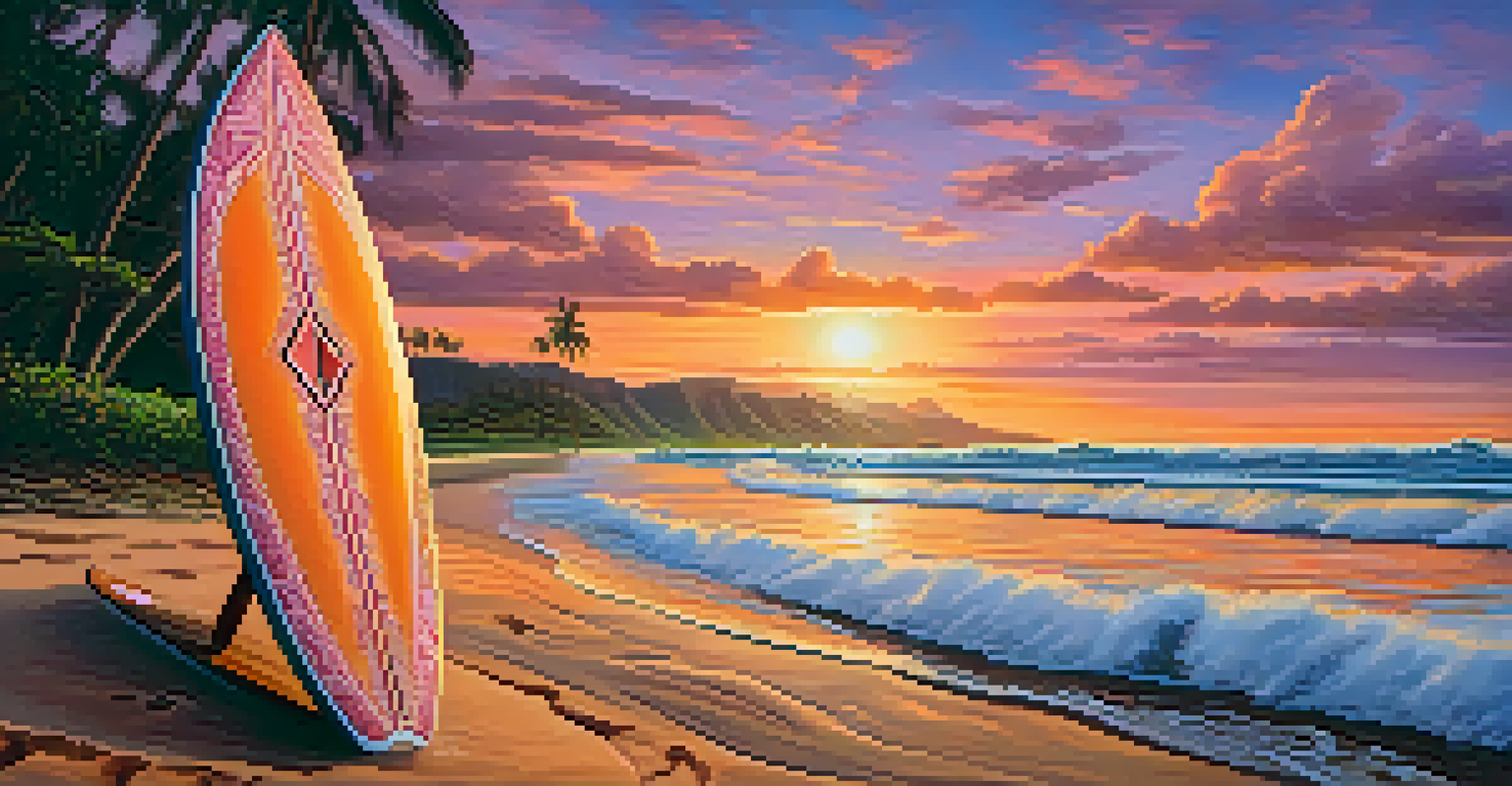The Origins of Surfing: Hawaii's Role in the Sport's Birth

Surfing: A Cultural Treasure of Ancient Hawaii
Surfing, known as 'he'e nalu' in Hawaiian, is more than a sport; it's a cultural treasure. Ancient Hawaiians engaged in this activity not just for fun but as a spiritual and social experience. It was a way to connect with the ocean, showcasing their skills and bravery against the waves.
Surfing is not just a sport; it's a way of life that connects us to the ocean and to each other.
These early surfers used wooden boards made from local trees, with sizes varying based on the rider's skill and size. The craftsmanship involved in creating these boards reflected the deep respect and connection Hawaiians had with the ocean. Surfing was woven into their daily lives and traditions, making it integral to their identity.
In Hawaiian society, surfing was also a means of social status. Chiefs, or ali'i, often surfed to demonstrate their prowess and gain prestige. This cultural significance laid the foundation for what would eventually become a global sport, starting right from the shores of Hawaii.
The Evolution of Surfing Techniques in Hawaii
As surfing grew in popularity among Hawaiians, various techniques and styles began to emerge. These methods were often passed down through generations, reflecting the community's values and respect for the art of riding waves. The evolution of these techniques demonstrated the ingenuity and adaptability of surfers to different wave conditions.

One notable advancement was the transition from heavy wooden boards to lighter, more maneuverable designs. This shift allowed for increased speed and agility, enabling surfers to perform more complex maneuvers. The innovation in board design was a game-changer, paving the way for more exhilarating surfing experiences.
Surfing's Cultural Roots in Hawaii
Surfing, or 'he'e nalu,' originated in Hawaii as a spiritual and social practice, deeply woven into the cultural identity of ancient Hawaiians.
Moreover, surfing techniques were often influenced by the natural environment. For instance, different islands had unique wave patterns that encouraged surfers to develop specific skills suited to their local conditions. This adaptability not only enhanced the sport but also fostered a deeper connection between surfers and their surroundings.
The Arrival of European Influence on Surfing
When European explorers arrived in Hawaii in the late 18th century, they encountered the thriving surf culture and brought their own perceptions of the sport. Initially, many viewed surfing as a curious pastime, but it quickly captured their imagination. This fascination helped to spread awareness of surfing beyond the shores of Hawaii.
The ocean stirs the heart, inspires the imagination, and brings eternal joy to the soul.
The introduction of new materials and ideas by Europeans also influenced the evolution of surfing. For example, the advent of metal tools improved the crafting of surfboards, allowing for a new level of precision and creativity in their design. These innovations contributed to the development of surfing as we know it today.
Despite the external influences, the essence of Hawaiian surfing remained strong. Hawaiians continued to uphold their traditions, ensuring that the cultural roots of surfing were not lost. This blending of cultures ultimately enriched the sport, creating a diverse tapestry that would attract surfers from around the world.
The Birth of Modern Surfing in the 20th Century
The early 20th century marked a pivotal moment in the history of surfing. With the rise of beach culture in the United States, surfing began to attract a broader audience, especially in California. This era saw the emergence of surf clubs and competitions, further popularizing the sport and its lifestyle.
Hawaii continued to play a crucial role in this transformation, as many surfers traveled to the islands to experience the legendary waves firsthand. Events like the Duke Kahanamoku's exhibition in 1914 showcased Hawaiian surfing to the world, inspiring countless individuals to take up the sport. The Duke, often referred to as the father of modern surfing, became an ambassador for Hawaiian culture.
Evolution and Global Expansion
Surfing evolved through innovations in board design and techniques, expanding from Hawaiian shores to become a global phenomenon embraced by diverse cultures.
As surfing gained popularity, new styles and techniques continued to evolve. The introduction of fiberglass boards in the 1950s revolutionized the sport, making it more accessible and allowing for greater experimentation. These advancements laid the groundwork for surfing to evolve into a global phenomenon.
Hawaii: The Heart of Surfing's Competitive Scene
Today, Hawaii is recognized as the heart of surfing's competitive scene, hosting prestigious events like the Pipeline Masters and the Vans Triple Crown of Surfing. These competitions attract the best surfers from around the globe, showcasing their skills in some of the world's most challenging waves. The islands' waves provide a perfect backdrop for these high-stakes contests.
Beyond the competitions, Hawaii remains a vital training ground for surfers. The diverse surf spots, from the mellow waves of Waikiki to the intense breaks of Waimea Bay, offer a range of challenges that help athletes hone their skills. This unique environment fosters a strong sense of community among surfers, who often share tips and techniques.
Moreover, Hawaiian surfers continue to push the boundaries of the sport, with many becoming champions in international competitions. Their deep-rooted connection to the ocean inspires a new generation of surfers, ensuring that the legacy of Hawaiian surfing remains vibrant and influential.
Surfing as a Global Phenomenon
As surfing spread across the globe, it transformed into a diverse and inclusive sport. From the beaches of Australia to the shores of Brazil, each location added its unique flavor to the surfing culture. This global expansion has made surfing a shared passion among millions, fostering international camaraderie among surfers.
However, despite its widespread popularity, the roots of surfing remain firmly planted in Hawaii. The islands continue to be a pilgrimage site for surfers seeking to connect with the sport's origins. This ongoing journey highlights the importance of preserving the cultural heritage of surfing.
Preserving Surfing's Legacy
As surfing gains popularity worldwide, there is a growing responsibility to preserve its Hawaiian roots and promote sustainability in ocean practices.
The rise of social media and surf documentaries has also played a significant role in this global phenomenon. Surfing is now more visible than ever, inspiring new enthusiasts to take to the waves. Ultimately, while surfing has evolved and diversified, its Hawaiian roots remain a central part of its story.
Preserving the Legacy of Hawaiian Surfing
As the popularity of surfing grows, so does the responsibility to preserve its cultural legacy, particularly in Hawaii. Many organizations and locals are dedicated to protecting surf spots and educating newcomers about the importance of Hawaiian traditions. This commitment ensures that the sport remains respectful and true to its origins.
Additionally, the rise of eco-conscious surfing practices highlights the need to protect the ocean and its ecosystems. Many surfers are now advocates for sustainability, recognizing that a healthy ocean is essential for the sport's future. This shift in mindset embodies the deep respect Hawaiians have always had for their environment.

Ultimately, preserving the legacy of Hawaiian surfing involves more than just maintaining traditions—it’s about fostering a sense of community and responsibility among surfers worldwide. By honoring the sport's roots, future generations can continue to enjoy the waves while respecting the culture that birthed surfing.